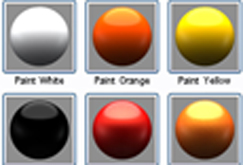HDR Light Studio 1.0 – Modern rendering tools use HDR images to create realistic lighting and scenery – a kind of virtual camera for digital products. But what if you want to adapt HDR scenes for specific requirements? Al Dean gets all excited by a new product that can do just that.
The rendering world today is radically different from that of two years ago and the rise of the progressive renderer is seemingly unstoppable. With the likes of Bunkspeed, SolidWorks/Luxology and some forthcoming technology from ARTVPS, photorealistic rendering has moved from becoming a complex and time consuming process, to something readily achievable by the majority.
While progressive rendering allows us to take advantage of the incredibly powerful multi-core hardware in basic workstations and laptops, another piece of technology is making the set-up of those scenes much easier. The use of High Dynamic Range (HDR) images as the basis for lighting set-ups in rendering is nothing particularly new; it’s the adoption by mainstream tools that is.

HDR brings the ability to store a much higher level of information about the lighting within a specific scene. In specifics, each pixel stores not only the colour of the light at that particular point, but also its intensity. When used in rendering, this offers two advantages.
Firstly, because a HDR file typically captures a 360 degree view of a scene, there is little need for the user to set-up ‘scenery’ in which to place their digital products.
Secondly, the reflections match and light is much more realistic. Highlights also look as real as they are going to get because they’re based on physically-accurate data. So, the combination of highly efficient rendering code, along with the ability to capture and reuse accurate light and scenery information, delivers a much more capable set of tools.
A typical rendering system ships with a handful of standard scenes, a lighting studio for product shots and usually a random exterior scene – for those that want to render their product in a desert or on a gravel track. But what if something specific is required? One option is to invest or rent a HDR capture device, such as those offered by Spheron.
These are typically used to capture scenes for high-value work (such as automotive photo-shoots) or by providers of the growing number of online HDR libraries. Here, a wide range of HDR images are made available for purchase, download and use, but typically these are aimed at the higher-end of the market, such as the advertising agency or rendering bureaux and don’t reflect the need of the average user. There is also the question of being able to fine tune the HDR images, in order to achieve a specific look and feel for the final render.

HDR excels at capturing exactly what is there at that point in time and fine tuning in most systems is limited to brightness and contrast controls. To properly dig in and edit HDR images requires hour upon hour of Photoshop work.
There is now an easier option. HDR Light Studio is a brand new product from the team at Protograph, a UK-based rendering and visualisation service provider. In short, the product provides the type of control and adaptability needed to create a HDR studio type lighting scheme from scratch.
Once installed and licensed, the system is driven from a very simple, single window. Here, the user has the ability to create a range of light shapes, of different intensities and adapt the background to specific colour and light requirements. However, the real benefits are in the details. HDR images are stored in a full 360 degree spherical manner. To create accurately-shaped lights requires adaptation of the light shape, so when used in rendering they appear as required (a rectangular light box is rectangular – a circular one is circular).

As the user positions the light, the shape changes to ensure that the required results are achieved. Lights can be ‘layered up’ to create more abstract forms, colours can be changed, and intensity (measured in wattage) and fall off adapted to achieve the required light set-up. The user can flick through different exposures to ensure the right look and feel is obtained then, once ready, simply hits the render button and the system generates the HDR image.
Here, the team’s background in production rendering is evident, as a variety of resolutions are given. The preview 1,500 x 750 calculates very quickly and allows the user to load it into his rendering tool, see the given effect, make changes if required, and then render out to his chosen resolution, all the way up to 5,000 x 2,500. The system supports both the HDR and EXR formats, which can be readily used by the majority of systems out there. That’s it, it’s that simple. We think the results speak for themselves.
Conclusion
For any new generation rendering product that is capable of taking high-quality, ultra photorealistic virtual photographs of digital products, HDR Light Studio is able to provide the digital version of a professional lighting rig and backdrop that would typically accompany any product photo shoot.

While the results speak for themselves, the real beauty of HDR Light Studio is that it accomplishes all this through a very lightweight application, where the user can utilise his skill, knowledge and specify precisely how he wants his product photos to appear, creating truly stunning imagery without having to leave the comfort of the office and also without a substantial investment.
From speaking to the development team, there are plans to add more functionality to allow standard HDR images to be taken off the shelf and lights and darkness added where required (which will be truly impressive). For many, the pre-set environments in their rendering software tool of choice will suffice and serve them well. That said, for those that take extra care, extra effort and pride in their renders, where perfection is the only option, this application is a must have.
www.hdrlightstudio.com
| Product | HDR Light Studio 1.0 |
|---|---|
| Company name | Protograph |
| Price | £499 |






